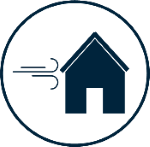|
This summer, wildfires have spread across the U.S. creating devastation and dangerous smoke events affecting millions of American lives. If you are in need of immediate wildfire guidance, see EPA’s wildfire webpage for more resources.
Photo from FEMA / Bryan Dahlberg of a smoke event
Smoke from wildfires in the United States can adversely affect indoor air quality and put people’s health at risk from exposure to particulate matter and other pollutants. During a wildfire, smoke can make the outdoor air unhealthy to breathe, and local officials may advise you to stay indoors during a smoke event. However, some of the smoke from outdoors can enter the home and reduce indoor air quality. Exposure to fine particles, a major component of wildfire smoke, can cause respiratory symptoms and aggravate chronic heart and lung diseases.
Read on to learn more about:
How Indoor airPLUS Homes Protect Against the Harmful Effects of Wildfire Smoke

Indoor airPLUS is a comprehensive, whole-building system approach to a healthier home. Indoor airPLUS labeled homes are equipped with features that can help provide cleaner air to breathe during wildfire smoke events by reducing exposure to particulate matter and other pollutants. However, additional steps may be necessary to help protect occupants in extreme wildfire events.
Visit the Indoor airPLUS and Wildfires webpage for more information about how a well-designed and operated Indoor airPLUS home can help protect homeowners and occupants against the adverse effects of wildfire smoke. See below for features of an Indoor airPLUS labeled home:
|
Source Control

Improving source control with a tight building envelope is a critical step to reducing exposure to wildfire smoke inside the home. Air that leaks through your home’s building envelope − the outer walls, windows, doors, and other openings – not only wastes energy, but puts you and your family at risk from outdoor pollutants. Indoor airPLUS labeled homes include features that enhance the home building envelope to help keep out hazardous wildfire smoke.
|
Ventilation

Ventilation is another key component of a healthy home, and Indoor airPLUS homes include whole building mechanical ventilation systems that provide a measured amount of fresh air for the occupants. However, during extreme events, homeowners and/or building managers may need to take additional measures to help control when outdoor air comes into the home. During wildfire events, the occupant can temporarily turn off their mechanical ventilation system to reduce the amount of wildfire smoke entering the home. Then once the wildfire smoke event has ended, the resident can resume normal ventilation to help dilute indoor air contaminants.
|
Filtration

Improved filtration helps remove particles from the indoor environment, including particles contained in wildfire smoke. The Indoor airPLUS Construction Specifications require a minimum MERV 8 filter to be installed in central forced-air HVAC systems, but EPA highly recommends a MERV 13 filter for added protection.
High-efficiency filters help remove small particles from the air that can cause adverse health effects, so upgrading HVAC filtration has the potential to make important improvements in indoor air quality for homeowners. What this means is that homeowners can breathe cleaner air and have peace of mind knowing their home is equipped to help manage harmful airborne particles, including those from wildfire smoke.
Note: Not all Indoor airPLUS homes include ducted, forced-air heating and cooling systems capable of using high-efficiency filters. For example, some homes are conditioned with ductless mini-splits or hydronic systems. In these cases, EPA recommends the use of a portable air cleaner when a high-efficiency HVAC filter is unavailable, and such a recommendation or requirement may be included in future revisions to the Indoor airPLUS specifications.
|
Reduce Exposure to Wildfire Smoke Inside the Home
Wildfire smoke could impact your indoor air quality (IAQ) differently depending on the proximity of the fire and the density of the smoke. If you are close to a wildfire, the fire itself, as well as heavy smoke and ash, can pose serious, immediate risks to your safety and health. You and your family should be prepared to evacuate immediately if told to do so.
When wildfires create smoky conditions, there are things you can do, indoors and out, to reduce your family's exposure to smoke. Reducing exposure to smoke is important for everyone’s health — especially children, older adults, and people with heart or lung disease. The Reduce Your Smoke Exposure fact sheet describes what you can do. If local officials advise you to stay indoors, there are many actions you can take within your home to reduce smoke exposure, such as setting up a clean room.
Infographic: Reduce Health Risks In Areas With Wildfire Smoke available at: www.airnow.gov/publications/fire-mask-respirator-and-palm-cards-in-seven-languages/infographic-reduce-health-risks/
A clean room is a room that is set up to keep levels of smoke and other particles as low as possible during wildfire smoke events. See below for steps to creating an effective clean room:
-
Choose a room. It should be big enough to fit everyone in your household and comfortable to spend time in. A bedroom with an attached bathroom, for example, is a good choice because you can close it off from the rest of the house and keep the door closed for long periods of time.
-
Prevent smoke from entering the room. Close all windows and doors in the room, but don’t do anything that makes it hard to get out. If there is an exhaust fan or range hood in the clean room space, only use it for short periods.
-
Stay cool. Run fans, window air conditioners, or central air conditioning. If your HVAC system or window air conditioner has a fresh air option (meaning it pulls in air from the outside), turn it off, close the intake, or set the system to recirculate mode. Avoid using an evaporative cooler or portable air conditioner with a single hose in smoky conditions unless there is a heat emergency. Using these devices can result in more smoke being brought inside.
-
Filter the air in the room. Use a portable air cleaner that is the right size for the room. Run the portable air cleaner continuously on the highest fan setting if you can. Pick one that does not produce ozone. If you have central HVAC, you can also install a high-efficiency filter (MERV 13 or higher) in the system. Run the system’s fan as often as possible to get the most out of the filter.
During periods of heavy smoke, plan to replace the filter in your air cleaner or HVAC system more often than recommended by the manufacturer. If you notice that filters appear heavily soiled when you replace them, you should consider changing them more frequently.
See the Indoor Air Filtration fact sheet and EPA’s Guide to Air Cleaners in the Home for more information.
-
Avoid activities that create smoke or other particles indoors, and dust or mop surfaces in the clean room with a damp cloth as needed to keep settled particles from getting back into the air.
Learn more about fine particles in indoor air.
-
Spend as much time as possible in the clean room to get the most benefit from it. Avoid exercising while in the clean room to help reduce exposure to any particles that may enter the room. When the air quality improves, even temporarily, air out the clean room by opening windows or open the fresh air intake on your HVAC system to freshen the air.
Additional Resources
Active fire near buildings in Los Angeles
For more information from EPA regarding wildfires, please visit these websites:
Still have questions on how an Indoor airPLUS home can benefit you? Check out the Benefits and Features page or contact us at Indoor_airPLUS@epa.gov.
Please feel free to contact us with any questions about Indoor airPLUS.
Best regards,
The Indoor airPLUS Team
|